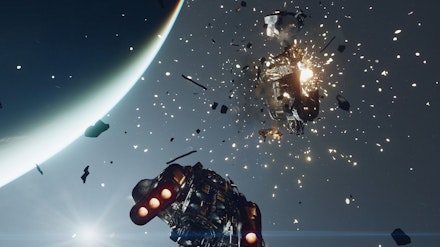Platforms: Xbox Series X|S, PC
It’s almost impossible not to notice the similarities between Starfield and No Man’s Sky. Both titles set you adrift in a vast gulf of stars, free to explore in whatever direction you like, just see what’s out there. Both rely heavily on mining minerals and scanning surroundings in order to craft crucial components and learn more about the universe. And, both depend on things being a little weird out there in the cosmos.
The difference is one of scale. No Man’s Sky took years to grow from a lonely, almost poetic examination of unknowable cosmic existence into a vast space epic filled with everything from colony building to fleet battles. In contrast, Starfield warps straight to that endpoint, presenting an unfathomably large and complex galactic tapestry crammed with history, politics, lore, and established systems from day one. It’s an approach that both works for and against the game.

In the plus column, having such a well-developed and deeply considered universe means there’s some much-needed structure to frame your adventures. You Start off as a humble space miner, before an encounter with a strange artefact and the visions it places in your mind see you recruited by a reclusive explorers’ guild known as Constellation, seeking the secrets behind the object and others like them.
Bethesda’s promotional machine spoke frequently of how Starfield is the first brand new world from the studio in decades, but players familiar with Fallout or The Elder Scrolls will notice how familiar it all seems, particularly to the former. There’s a similar feel to its gunplay, its crafting, even its encumbrance systems, that often mark it as cut from the same cloth, merely swapping a post-apocalyptic brand of sci-fi for a star-hopping one. There’s also a touch of Firefly to its mythos, with humanity having abandoned Earth but not yet found any other sentient life, leaving plenty of room for satire and outright condemnation of capitalism operating on a galactic scale, with petty human greed ruining everything.
An unfathomably large and complex galactic tapestry crammed with history, politics, lore and established systems.
Of course, you have the flexibility to partake in that greed just as easily as you might aim to become an altruistic hero. Like its Bethesda stablemates, Starfield doesn’t demand players follow its core missions, allowing you to almost immediately ignore everything and go wherever and do whatever you like, instead. The freedom is intoxicating - it’s all too easy to spend literally dozens of hours hopping around a single planet, hunting down markers in the distance to see what’s there or mining resources to sell for a fortune, without ever following a main quest line.
In the negative column though, that same depth, complexity, and freedom means everything rapidly overwhelms. And we mean everything - from the narrative and social aspects, where the slightest mistake in interacting with the array of factions operating across the universe can send your personal story arc careening off in unwanted directions, to the mechanical, where the game’s similarly multitudinous suite of overlapping controls and gameplay features often leave you confounded.

This is the duality of Starfield - for every moment of genuine awe as you explore an alien world, there’s one of immense frustration as you struggle to figure out how to do something comparatively simple, like dock your spacecraft with an orbiting station. For every thrilling shootout against hardened space pirates, there’s a protracted struggle in remembering how to merely travel between locations - a problem borne of maps at planetary, system, and galactic scales, with confusing layouts. There are even contradictions in basic controls, such as being able to pick up some objects while you’re in the scanner view, but others that force you to return to normal view to grab.
Still, perhaps some of this is unavoidable for a game of the sheer size and ambition of Starfield. There are side features here of such complexity that they could conceivably form entire games in their own right, such as building outposts or constructing starships. These are aspects that you could sink further dozens of hours into on their own merits, requiring their own set of controls and rulesets to operate, and that almost by necessity create some clashes with how other parts of the game work. The core problem is that Bethesda so poorly explains pivotal aspects of the game to players. If there is a prompt or micro-tutorial for something, it’s often delivered at specific points along a quest chain, long after you’ve already struggled with a given issue while off seeing what the universe has to offer.
All of which means that unlike Fallout or TES, you probably shouldn’t take up Starfield’s promises of unfettered freedom, at least on your first playthrough. This is a game where you really need to already know how everything works to get the greatest enjoyment out of it, and so players will be better served by blasting through the core campaign as fast as possible to get that foundation, then really seeing what this universe has to offer in its New Game+ mode. Of course, that’s a prospect that demands a time commitment many won’t be able to make, but for those who can, Starfield will truly soar.
